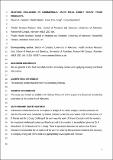Files in this item
Seafood inclusion in commercial main meal early years' food products
Item metadata
| dc.contributor.author | Carstairs, Sharon Ann | |
| dc.contributor.author | Marais, Debbi | |
| dc.contributor.author | Craig, Leone | |
| dc.contributor.author | Kiezebrink, Kirsty | |
| dc.date.accessioned | 2016-08-24T11:30:09Z | |
| dc.date.available | 2016-08-24T11:30:09Z | |
| dc.date.issued | 2016-10 | |
| dc.identifier | 245113074 | |
| dc.identifier | d1f9d640-d244-46e3-a611-c60d362406a9 | |
| dc.identifier | 84928172354 | |
| dc.identifier.citation | Carstairs , S A , Marais , D , Craig , L & Kiezebrink , K 2016 , ' Seafood inclusion in commercial main meal early years' food products ' , Maternal and Child Nutrition , vol. 12 , no. 4 , pp. 860-868 . https://doi.org/10.1111/mcn.12185 | en |
| dc.identifier.issn | 1740-8709 | |
| dc.identifier.other | ORCID: /0000-0001-6593-5972/work/48774948 | |
| dc.identifier.uri | https://hdl.handle.net/10023/9368 | |
| dc.description | The study was funded by the Seafish and Interface Food and Drink as part of a Doctorate Scholarship undertaken at the University of Aberdeen. | en |
| dc.description.abstract | Seafood consumption is recommended as part of a healthy, balanced diet. Under-exposure to seafood during early years feeding, when taste and food acceptance is developed, may impact on the future development of a varied diet. This study aimed to investigate the availability and nutritional content of seafood in commercial infant meals compared to the other food types. A survey was conducted of all commercial infant main meal products available for purchase in supermarkets, high street retailers and online stores within the United Kingdom. The primary food type (seafood, poultry, meat and vegetables) within each product, nutritional composition per 100 g, and ingredient contribution were assessed. Of the original 341 main meal products seafood (n = 13; 3.8%) was underrepresented compared to poultry (103; 30.2%), meat (121; 35.5%) and vegetables (104; 30.5%). The number of the seafood meals increased three years later (n = 20; 6.3%) vegetable meals remained the largest contributor to the market (115; 36.4%) with meat (99; 31.3%) and poultry (82; 26.0%) both contributing slightly less than previously. Seafood-based meals provided significantly higher energy (83.0 kcal), protein (4.6 g), and total fat (3.2 g) than vegetable (68 kcal, 2.7 g, 1.9 g), meat (66 kcal, 3.0 g, 2.1 g) and poultry-based meals (66 kcal, 3.0 g, 2.1 g) and higher saturated fat (1.3 g) than poultry (0.4 g) and vegetable-based (0.6 g) meals (all per 100 g) which may be attributed to additional dairy ingredients. Parents who predominantly use commercial products to wean their infant may face challenges in sourcing a range of seafood products to enable the introduction of this food into the diet of their infant. | |
| dc.format.extent | 428132 | |
| dc.language.iso | eng | |
| dc.relation.ispartof | Maternal and Child Nutrition | en |
| dc.rights | © 2015, John Wiley & Sons Ltd. This work is made available online in accordance with the publisher’s policies. This is the author created, accepted version manuscript following peer review and may differ slightly from the final published version. The final published version of this work is available at onlineilbrary.wiley.com / https://dx.doi.org/10.1111/mcn.12185 | en |
| dc.subject | Infant feeding | en |
| dc.subject | Seafood | en |
| dc.subject | Complementary feeding | en |
| dc.subject | Pre-prepared foods | en |
| dc.subject | Baby food | en |
| dc.subject | Early years | en |
| dc.subject | RA0421 Public health. Hygiene. Preventive Medicine | en |
| dc.subject | RJ Pediatrics | en |
| dc.subject | NDAS | en |
| dc.subject | SDG 3 - Good Health and Well-being | en |
| dc.subject.lcc | RA0421 | en |
| dc.subject.lcc | RJ | en |
| dc.title | Seafood inclusion in commercial main meal early years' food products | en |
| dc.type | Journal article | en |
| dc.contributor.institution | University of St Andrews.School of Medicine | en |
| dc.identifier.doi | 10.1111/mcn.12185 | |
| dc.description.status | Peer reviewed | en |
This item appears in the following Collection(s)
Items in the St Andrews Research Repository are protected by copyright, with all rights reserved, unless otherwise indicated.

